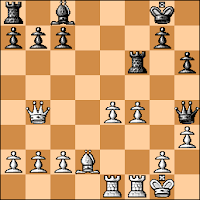Gerald Abrahams wrote in his book, The Chess Mind, that the smallest unit in a chess game was not the move, but the idea. I've always believed that he was onto something, although I'm sure that he still divided ideas into good and bad ones, just as he divided moves into good and bad ones. After all, he once wrote
...and nobody in their right senses plays... Jerome's Gambit
perrypawnpusher - GiantReign
blitz FICS, 20101.e4 e5 2.Nf3 Nc6 3.Bc4 Nf6
The Two Knights Defense. No Jerome Gambit today, I guess. Unless...
4.Nc3 h6 5.0-0 Bc5
6.Bxf7+
Ah, the Semi-Italian Four Knights Jerome Gambit... But, do I really want that? As they say: be careful what you wish for, you just might get it!
6...Kxf7 7.Nxe5+ Nxe5 8.d4
8...Neg4
Fascinating.
Maybe I'm supposed to kick the Knight with h2-h3, while Black withdraws his Bishop to b6 and looks at the possibility of h6-h5, opening the King's Rook file...?
9.dxc5 Re8
I settled for just taking the Bishop. In turn, Black's move prepared for castling-by-hand. He also prepared an unfriendly retort to my see-able 13th move...
10.h3 Ne5 11.f4 Nc6 12.e5 Nh7
Those frisky "Jerome pawns"! The game is about even.
13.Qd5+ Kf8 14.Bd2 d6 15.cxd6 Be6
After the game Rybka suggested a line that was stronger for Black then this move, but messier: 15...cxd6 16.Ne4 Qb6+ 17.Kh2 Be6 followed by 18.Qxd6+ Kg8 19.Qd3 Qxb2 20.Nd6 Rad8 21.Rab1 Qxa2 22.Rxb7 Re7 23.Rfb1 Qd5 with an even game.
16.Qe4 cxd6
Probably an oversight: 16...Kg8 minimized White's edge.
17.Qxh7
17...dxe5
Still hammering at the center pawns, but the game has taken a bad turn in any event.
18.fxe5+ Ke7 19.Qxg7+ Bf7 20.Qxf7 checkmate

































































